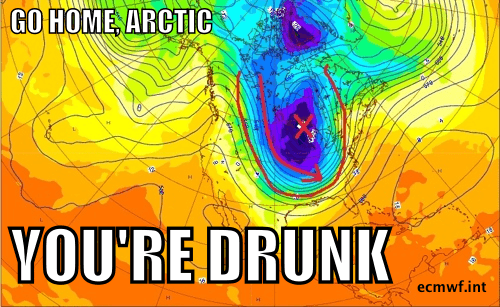The term “Polar Vortex” was thrown around a lot last year, in reference to the persistent mass of very cold air that enveloped much of southern Canada and the US. As you will remember, Rush Limbaugh accused climate scientists and librul meteorologists of making up the polar vortex to scare everyone into thinking climate change is real. You may also remember Al Roker pointing out on national TV and on Twitter that the term “polar vortex” has been in meteorology textbooks for decades.
This year, with a new wave of cold air arriving unseasonably in the upper middle part of the US, the term is being used again. I was amused to see the term being used on accuweather such that it was placed on each of several graphics used to show that this year’s cold snap is not actually the polar vortex, unlike last year.
It turns out that while the polar vortex is a real thing, it really is not the correct term to apply to either last year’s cold incursion or the current cold spell. The polar vortex is a thing that gets going in a big way during the norther Winter, and swirls around all vortexy at high altitude over the pole. It can become more or less compact, more or less well defined, and it certainly has a relationship to the weather. But the proper term for a huge bundle of cold air heading south and freezing us out would not be “polar vortex” but rather, something like “cross-polar flow with low-level winds advecting frigid air southward from polar regions” (see this for a great discussion of what the polar vortex is and isn’t). At least in some cases; other descriptions may apply in other cases.
The unseasonable cold air is potentially important, especially if large scale bending of the jet streams that can cause these “troughs” of cold air to move farther south than typical are more common because of global warming (see this).
Anyway, I was wondering exactly how the term was originally introduced into the conversation last winter, so I used google to narrow down its occurrence and found these:
AP, on January 3rd 2014:
Temperature records will likely be broken during the short, yet forceful deep freeze that will begin in many places on Sunday and extend into early next week. That’s thanks to a perfect combination of the jet stream, cold surface temperatures and the polar vortex — a counterclockwise-rotating pool of cold, dense air, said Ryan Maue, of Tallahassee, Fla., a meteorologist for Weather Bell.
“All the ingredients are there for a near-record or historic cold outbreak,” he said. “If you’re under 40 (years old), you’ve not seen this stuff before.”
New York Mag, January 4th, 2014:
… there’s something happening in the country called a “polar vortex” or, as Weather Bell meteorologist Ryan Maue called it, a “frigid air blanket.”
Maue said the cold air system is caused by a “counterclockwise-rotating pool of cold, dense air, once piled up at the North Pole, and pushed down to the U.S.” It’s expected to arrive Sunday.
Huffington Post, January 3rd, 2014:
Temperature records will likely be broken during the short, yet forceful deep freeze that will begin in many places on Sunday and extend into early next week. That’s thanks to a perfect combination of the jet stream, cold surface temperatures and the polar vortex — a counterclockwise-rotating pool of cold, dense air, said Ryan Maue, of Tallahassee, Fla., a meteorologist for Weather Bell.
“All the ingredients are there for a near-record or historic cold outbreak,” he said. “If you’re under 40 (years old), you’ve not seen this stuff before.”
So, the common ingredient in the misuse of the term “polar vortex” is a meteorologist Ryan Maue, of Weather Bell. He’s the one that screwed this up originally and the press kind of took off with it.
You can’t totally blame the press. Given the choice between “polar vortex” and “advecting cross polar flow yadayada” it isn’t a hard choice. If they were both right, and they just didn’t know.
Ryan Maue, by the way, is a climate change science denier. I checked my twitter list of climate change deniers and he is on it. That means he annoyed me on twitter with his climate change science denial yammering. So a science denier came up with this bone headed misuse of a term and the press more or less blindly went along with it.
As my friend Paul Douglas notes, in speaking of the polar vortex problem vis-a-vis our current cold snap “For me the bigger question is will it last? What made last winter’s polar displacement so unusual was its persistence. The bitter blob all but stalled for the better part of 3 months.”
Long term predictions for this winter suggest an average winter, but for many parts of the US a bit warmer than average. So far the weather is not cooperating with the prediction. I predict that the prediction will be wrong because I suspect the models used to make these predictions don’t properly account for the increased frequency of formerly rare phenomena related to the jet streams. But, on the other hand, eventually there is supposed to be a shift to official El Nino conditions. (The Pacific is already El Nino warm, just not acting El Nino-ish in other ways). So, really, I’m predicting a warmer than average winter in the Northern Hemisphere but with the 5% or so of that hemisphere occupied by the largest concentration of climate science deniers, Americans, colder than average. It is like Climate Change doesn’t want to be believed in by Americans. It wears an invisibility cloak.






